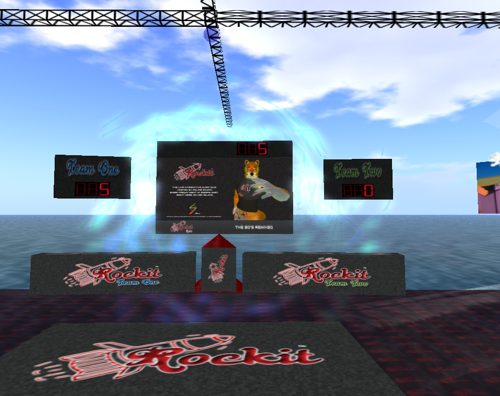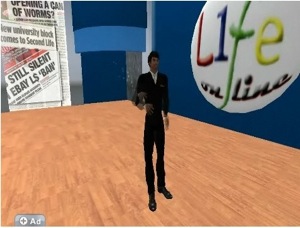1. The Spy Who Lives Here
2. Hinterland Orkney: Scotland in Second Life
3. Mutiny in Second Life
Tech -- Culture -- Humour
1. The Spy Who Lives Here
2. Hinterland Orkney: Scotland in Second Life
3. Mutiny in Second Life
A yearly highlight in Second Life is the American Cancer Society’s Relay for Life. The 2007 and 2008 events were big successes, with more than 55 million Linden Dollars (approximately 200 thousand US dollars).

Teams have started forming and if any Australian or New Zealand teams are forming, do let us know and we’ll promote your fundraising efforts. The team registration form can be found here.
The Australian Relay for Life is a superb community event for a lot of towns and cities. The Second Life version achieves that same community vibe and it’s an opportunity to remember those lost to cancer, to support those currently fighting cancer and to help find more effective treatments for cancers.
Thanks to SL Entrepreneur Magazine for the heads-up.
The key to managing crises,
is to keep an eye on the long-term,
while you’re dancing in the flames
You may have heard of TED talks: some of the world’s best thinkers (and doers) speak on some consciousness expanding topics. At the 2009 TED Conference, Juan Enriquez made a fascinating presentation on how the convergence of cell engineering, tissue engineering and robots would lead to the next iteration of the human species. If you have a spare 18 minutes, do watch the following and read on afterwards:
The information provided by Enriquez is likely to have caused a mixture of emotions, including fear, amusement and excitement. The same emotions apply to the current economic situation and also to virtual worlds. To draw a longer bow, Enriquez’s vision is hard to imagine without virtual worlds playing an intrinsic role. They are already perceived as a key collaboration tool, and the same technological evolution Enriquez speaks of will ensure that collaboration becomes more productive. Full walk-throughs of organs are available now in Second Life – it’s reasonable to assume that the much more advanced modelling solutions employed by researchers will find their way online in coming years.
In 2009, the virtual worlds industry is talking about the momentum in virtual meeting spaces and the growing work on interoperability. The innovators Enriquez cites are are creating stem cells from skin or robots that can already pass the physical equivalent of a Turing Test. The latter are well and truly the most groundbreaking but the former will continue to play a pivotal supporting role.
Enriquez paints a bleak picture in his presentation of the economic wave that is currently causing so much distress worldwide. He rightly shows a much bigger second wave of technological change occurring. Innovation is undoubtedly key to surviving the first economic wave. The second wave contains a lot of promise but it may also drown a lot of people. Those that it doesn’t overpower may literally be another human sub-type. It throws a whole new light on the term ‘geek’. They may rule the earth after all.
Thanks to Caleb Booker for the YouTube video link.
1. Clever Zebra have made their Virtual Worlds for Business eBook a free download – all the details here.
2. ABC Island in Second Life sees the return of music trivia show Rockit this Friday night at 8.30pm AEDT. Everyone has a chance of being a contestant and it’s a lot of fun.

3. It’s always a small world: research shows that people in MMOGs congregate with people geographically close to them:
“It’s not creating new networks. It’s reinforcing existing networks. You can talk to anyone anywhere, and yet individuals 10 kilometers away from each other are five times more likely to be partners than those who are 100 kilometers away from each other.”
4. We’re well and truly still running our Victorian Bushfire fundraiser – all the details here.
1. Los Angeles Times (USA) – Virtual Muslim world bans drinking, sex. “Ever wanted to experience life in the Muslim world but didn’t have enough money to fly to Cairo? The first-ever virtual version of the Muslim world was recently launched online. Muxlim Pal lets you adopt an animated avatar and interact with others online in a virtual world governed by the rules of Islam. You can shop, socialize in a beach cafe and, of course, pray at a mosque. Aimed at Muslims and non-Muslims, the website aims to foster understanding and communication between East and West.”
2. CNET (USA) – Littlest Pet Shop virtual world about to yipLittlest Pet Shop is going virtual.
Those tiny, plastic creatures with the larger-than-life googly eyes are set to come to life in the virtual world this fall, with manufacturer Hasbro and gaming giant Electronic Arts teaming up to launch the site, the companies said Thursday. The site, which will be banking on the popularity of the 2-inch idols, will be jumping into a tween market that is already heavily populated with the likes of the Webkinz, Disney’s Club Penguin, and start-up Dizzywood. Once launched, the Littlest Pet Shop site aims to offer preteens the ability to customize their favorite pets, participate in games and events on the site, and dive into social networking with friends.”
3. The Nation (Thailand) – Sun Microsystems and Kasetsart University drive Virtual World Innovation in Thailand with ‘Project Wonderland’ Technology. “Sun Microsystems (Thailand) and Kasetsart University launch the ‘Wonderland Challenge 2009’ – a competition encouraging students to innovate and develop rich multimedia 3D virtual worlds using Project Wonderland, a 100% Java toolkit for creating collaborative 3D virtual worlds. Project Wonderland is an open source project currently supported by Sun Microsystems Laboratories, Sun’s research and development group. The objective of the ‘Wonderland Challenge 2009’ is to initiate the Education 3.0 movement and raise greater public awareness of the potential impact of emerging Virtual World Technologies in Thailand. This nationwide challenge is open to students who will be pitting their skills against their peers to create an innovative 3D virtual learning environment with ‘Project Wonderland’, a powerful open source solution that enables developers to build a collaborative virtual world easily.”
4. Religion Dispatches (USA) – Dreaming Cyborg Dreams: Virtual Identity and Religious Experience. “If it is true that, as theorist Sherry Turkle has claimed, that in our increasingly mediated world “we are all dreaming cyborg dreams,” it is certainly safe to say that at least some of these dreams are religious ones. In this essay, I look at four types of immersive new media that address the issue of religious identity: Waco Resurrection, a religiously-inspired first-person shooter, Noah’s Ark, a religious online reality show; Roma Victor, a massive multiplayer online role-playing game, and religious experiences in the online world of Second Life.”
5. MSNBC (USA) – Fantastic plastic? Barbie’s changing role. “Since its introduction to the toy world in 1959, the 11.5-inch plastic sensation originally known as Barbie Millicent Roberts has reflected the rise of the modern woman in society. But 50 years later, Mattel faces a challenge to sell the iconic dolls amid worldwide economic woes. And then there’s the biggest challenge Barbie faces — beating Barbie’s modern rivals in the marketplace. In a world where “hip” dolls are those with higher hemlines, sexy heels and heavy makeup. Can the more traditional Barbie survive another half century?”
6. Eureka! Science News (Canada) – Tracking the digital traces of social networks. “Why do we create and maintain social networks? Most people can immediately think of a few natural reasons — we get something from the interaction, or the person is nearby and is close to us in proximity, age or gender. But researching such theories on a large scale has never before been possible — until digital social networks came along. Noshir Contractor, the Jane S. and William J. White Professor of Behavioral Sciences at the McCormick School of Engineering and Applied Science at Northwestern University, has studied the massive online virtual world Second Life to test whether these and other social theories are true.”
7. New Scientist (UK) –Valentine’s Day Special: The dating game. “IF YOU’RE looking for love, chances are you have considered the online dating scene. According to Mark Brooks, editor of onlinepersonalswatch.com, half of singletons in the US – around 40 million people – now use internet dating. And a fair number, around 20 per cent, find long-term romance that way. So what is the best strategy? Psychologists who study romance are fascinated by this question as cyberspace changes all the rules. Online, you can be who you want to be. Just ask David Pollard. Pollard’s avatar in Second Life is Dave Barmy, a sharp-dressing hunk with flowing locks, designer stubble and sunglasses. Real-life David is bald, fat and being divorced by his wife after she caught him having an online affair with another Second Life avatar.”
8. The Guardian (UK) – The killer app? Metaverse makes 3D games 2D. “A big problem for virtual worlds and other MMO environments is the gargantuan amount of space, processing power and RAM they take up on a computer. Developers have been chasing what they believe is the holy grail for some time – pared down, browser-based versions of the same content that feeds back into the full version of the game seamlessly. There was, for example, a text version of Second Life. ActiveWorlds resurfaced in 2007 when they announced a Facebook app of their virtual world. Still others, like the forthcoming Metaplace, have done away with downloadable content altogether, opting instead for browser-only experiences.”
9. Walrus Magazine (Canada) – Let’s All Be Neighbours on Will Wright Street. “I am a wriggling, water-borne spore. My life depends on how vigilantly I navigate treacherous currents full of predators. I chase drifting morsels of decaying flesh (my food), and kill off rivals (for what their brains, when consumed, might unlock in my own consciousness). For a scavenger like myself, these are inspiring waters, and after a few minutes of bottom feeding I advance up the food chain. Now I am a trematode, one of those ghastly liver flukes you get when you drink from the banks of the Mekong River. I look like a cartoon hot dog with eye stalks and tusks.”
10. New York Times (USA) – How Google Decides to Pull the Plug. “GOOGLE recently set the blogosphere abuzz by announcing that it was pulling the plug on several products. The victims included Lively, a virtual world that was Google’s answer to Second Life; Dodgeball, a cellphone service aimed at young bar-hoppers who wanted to let their friends know where they were hanging out; Catalog Search, which scanned paper product catalogs so they could be searched online; and Notebook, a simple tool that allowed people to take notes on Web sites they had visited.”
 I received a media release yesterday, announcing the launch of a virtual TV show, Life On Line.
I received a media release yesterday, announcing the launch of a virtual TV show, Life On Line.
It’s the latest project by Australian Steve Cropper, who produced a virtual worlds community called My Metaverse as well as a previous offering: The Late Show.
I watched the pilot episode and like any pilot, it’s pretty raw. The overall theme of the show is the multitude of ways that people spend time online, from Facebook to Wikis. The topics are covered in a fairly breezy way and it works to an extent. What doesn’t work for me in any way is the canned laughter. To say it’s annoying is an understatement – at points it harks back to some early TV shows in the 60’s where laughter appears in spots where there’s nothing to laugh at.
The news section featuring blogger Sigmund Leominster has promise, but the rest of the show to me seems to have a long way to go. It’s always great to see new options appear, and here’s hoping this is one that goes from strength to strength. The first episode launching today will determine to a large extent whether that’s the trajectory we’ll see.
Update – Episode 1 is now live, so you can judge for yourself the real deal:
1. The March OF JEDDAS TROLLS
(Jedda Zenovka is an Australian Second Life resident)
2. |=| ANCIENT MOTHER |=|
3. Second Life Tribute To Lloyd Featuring Dolla Dinezeo with Ginger Robertson Girls World
Then try this one out.
This letter was received by a retail store in South Africa.
It starts with acknowledging the debt and an intention to pay then “I would like to bring to your attention that you are not my only creditor. I have many more as important creditor’s as you, and whom I wish to pay too. That is why, each month I throw all the names
into a hat and draw one randomly.
The one drawn is paid immediately. I hope that yours will come out shortly!
Sincerely….
PS. I regret to inform you that given the harsh and threatening tone of your last letter, you will not be taking part in the next
three draws”.
 Virtual environments and the public Internet sport a bewildering array of economies, from purely fantasy economies to real money trading between users. Fundamentally, many of these are currency-based economies which we all understand – you purchase something you value and give something of value in exchange. That is, you buy something you want with some manner of currency.
Virtual environments and the public Internet sport a bewildering array of economies, from purely fantasy economies to real money trading between users. Fundamentally, many of these are currency-based economies which we all understand – you purchase something you value and give something of value in exchange. That is, you buy something you want with some manner of currency.
People generally have a whole lot more trouble with various license agreements, such as the GNU Licenses , or the Creative Commons licenses. Infringements of these licenses are common, and when challenged the infringers are often rather baffled. Either they do not understand that the content can be misused, or they do not understand why the ‘license nazis’ seem so put out.
Let’s break it down.
None of these licenses is technically ‘free’. Yes, they involve the use of content for no monetary cost, but that isn’t the same thing. There are multiple definitions of the word ‘free’ and if you apply the wrong ones, at best you’ll be confused, and at worst you’ll end up looking like an ass. So, these licenses are ‘free’ as in ‘no monetary cost’, but they are not ‘free’ as in ‘given freely for no exchange in value’.
These licenses are your basic, free-market, capitalistic contract. The owner of the property has something of value (the exercise of certain rights with respect to that content) and their release of some of those rights under a license makes that value available in exchange for something of value to them (your compliance with the terms of the license).
You both get something you want out of it, in short. That’s basic capitalism at work. Money need not be a component of the exchange, demagoguery notwithstanding. However, this is the fundamental principle that a lot of people miss, because they mistake the various different definitions of ‘free’.
If you take the content and use it in ways that don’t comply with the license terms, it is essentially the same as refusing to pay. That is why people get steamed about it. The rights to use the content in certain ways is given to you based solely on your agreement to comply. No money is changing hands, but ongoing compliance to the terms of the license constitute the payment for the usage.
Vint Falken was surprised to find that a texture that she made available under a Creative Commons Attribution Non-Commercial No-Derives license was being sold by a number of merchants in IMVU, some of whom claimed it as their own original work. Some of those merchants were even more surprised that she had any rights to her work at all.
KirstenLee Cinquetti quit providing her Second Life viewer binaries when pressed to comply with all the terms of the licenses that she was required to uphold in order to retain her permission to distribute viewer binaries. Some licenses require more compliance effort than others.
If you were handing over currency to obtain the necessary rights, that would be one thing. However, the purchase you are making is paid for with ongoing compliance to the terms. Quite often, you can simply arrange some alternative licensing or purchase scheme with the rights-holder. If you don’t, however, these licenses aren’t as simple as clicking ‘Yes, I agree’ somewhere and forgetting that you ever saw it. They’re contracts that require you to uphold your part of the bargain or lose what you gained.
Trying to evade or cheat the obligations under which content was granted to you wins you no friends either. As Bruce Perens points out:
don’t look for, and use loopholes in the Open Source licenses. Nothing makes your company look worse than taking unfair advantage of people who provided their work to you without charge, expecting in good faith that you’d honor their license.
Why? Because you took value from someone without the intention of paying the asking price. And that upsets everyone.
It really is as simple as that.
 It’s an understatement to say I’m really pleased to announce a further addition to the writing team at The Metaverse Journal.
It’s an understatement to say I’m really pleased to announce a further addition to the writing team at The Metaverse Journal.
Tateru Nino is a significant addition too – she’s one of the first Second Life writers I read and she was incredibly supportive of our initial efforts when we started in 2006. It’s also worth reading our 2007 profile of Tateru to glean more of a picture of her.
Tateru will be providing stories most weeks and she has a totally open brief. If you’ve read her work on Massively or its predecessor Second Life Insider, you’ll know how thorough her research is.
No-one knows Second Life better and I for one am already excited about the stories she’ll be writing over coming weeks.
Welcome Tateru!
Copyright © 2024 · Magazine Child Theme on Genesis Framework · WordPress · Log in
Recent Comments